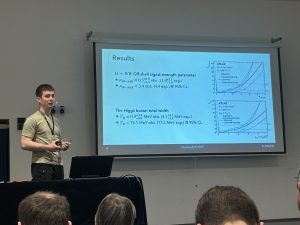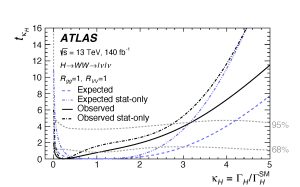At the Moriond conference in La Thuile, Italy, researchers from the ATLAS experiment at CERN presented the results of their research that teaches us more about one of the fundamental properties of the Higgs boson: its lifetime.
The Higgs boson, discovered in 2012 in collisions at the Large Hadron Collider (LHC), is responsible for the mass of elementary building blocks of the universe and thus indirectly for the formation of atoms, planets and stars. The lifetime of the Higgs boson tells how long the particle exists before it disintegrates into other particles. There is a clear theoretical prediction of the lifetime, but it is crucial to check it. Indeed, a faster decay could indicate a transition to new, undiscovered particles. An accurate measurement is a valuable and rigorous test of the Standard Model: determining the properties of the Higgs particle and an indicator of the existence of so-called “new physics”.

“Finding the Higgs particle is sometimes seen as the final piece of the LHC programme,” says PhD candidate Zef Wolffs from Nikhef who is closely involved in the analysis. “In reality, this discovery actually marks the beginning of a fascinating journey into the secrets of this extraordinary particle. One of the most important features in this quest is the lifetime of the Higgs boson.”
Higgs boson (on-shell and off-shell)
The Standard Model predicts exactly how and how often Higgs particles are made in particle collisions and how we can observe them in our experiments. A strange phenomenon in quantum theory is that particles with finite lifetimes do not always have the same mass. Although most Higgs bosons have the same mass (the famous Higgs peak – the so-called on-shell Higgs bosons), there is a small fraction that has a mass that is much larger. We call these Higgs bosons the “off-shell” signal. The researchers recently succeeded in isolating this tiny “off-shell” signal in the decay of the Higgs boson into two W bosons.
This is the first time this analysis has been done in a decade and the result is five times more accurate than the previous result. The ratio of “on-shell” and “off-shell” Higgs boson productions provides valuable information about the lifetime, which is exceptionally short with a predicted value of about 10^-22 seconds. The measured value of the “off-shell” Higgs boson production, and hence the lifetime, is consistent with the prediction of the Standard Model.
Deep neural networks
Using advanced machine learning techniques, the researchers have been able to better isolate the “on-shell” Higgs particles that decay into two W bosons. The ingenious technique used to find the tiny “off-shell” signal is based on the phenomenon of “quantum interference”. As in the famous two-slit experiment, processes in particle collisions with the same initial and final states can either reinforce or cancel each other out. The “off-shell” Higgs signal destructively interferes with certain background processes that also produce two W bosons, leading to a predicted deficit of events with two W bosons, compared to the prediction where there would be no “off-shell” production.
Thanks to the clear and easily identifiable signal in the detector, most of the attention so far has been on the H→ZZ decay channel. The same measurement in the H→WW channel is much trickier because it also produces neutrinos that leave the detector without leaving a trace, missing information. Nevertheless, the researchers succeeded by using deep neural networks and looking at six different combinations of production and decay channels.
Comparing the “on-shell” with the “off-shell” H→WW measurements constitutes the final step. The compatibility between the data and different hypotheses for the value of the width (1/lifetime) of the Higgs particle is shown in the figure. The most likely value of 0.9 MeV translates into a lifetime of 7.0 (^+82.1_-5.5) x 10^-22 seconds. This is within uncertainty consistent with the Standard Model’s prediction of 1.6 x 10^-22 seconds.
Wolffs: ‘Although the Standard Model has cracks here and there that indicate an incomplete description of our universe, the Higgs boson remains remarkably faithful to the predictions made more than 50 years ago.’
Dutch contribution
In the international research team with researchers from different countries, Nikhef researchers from the Netherlands have made significant contributions, notably PhD students Zef Wolffs, Bryan Kortman, postdocs Matous Vozak and Robin Hayes, and several Nikhef staff members.
More information on the ATLAS website:
https://atlas.cern
The results are published on arXiv:
https://arxiv.org/abs/2504.07710
https://arxiv.org/abs/2504.07686
